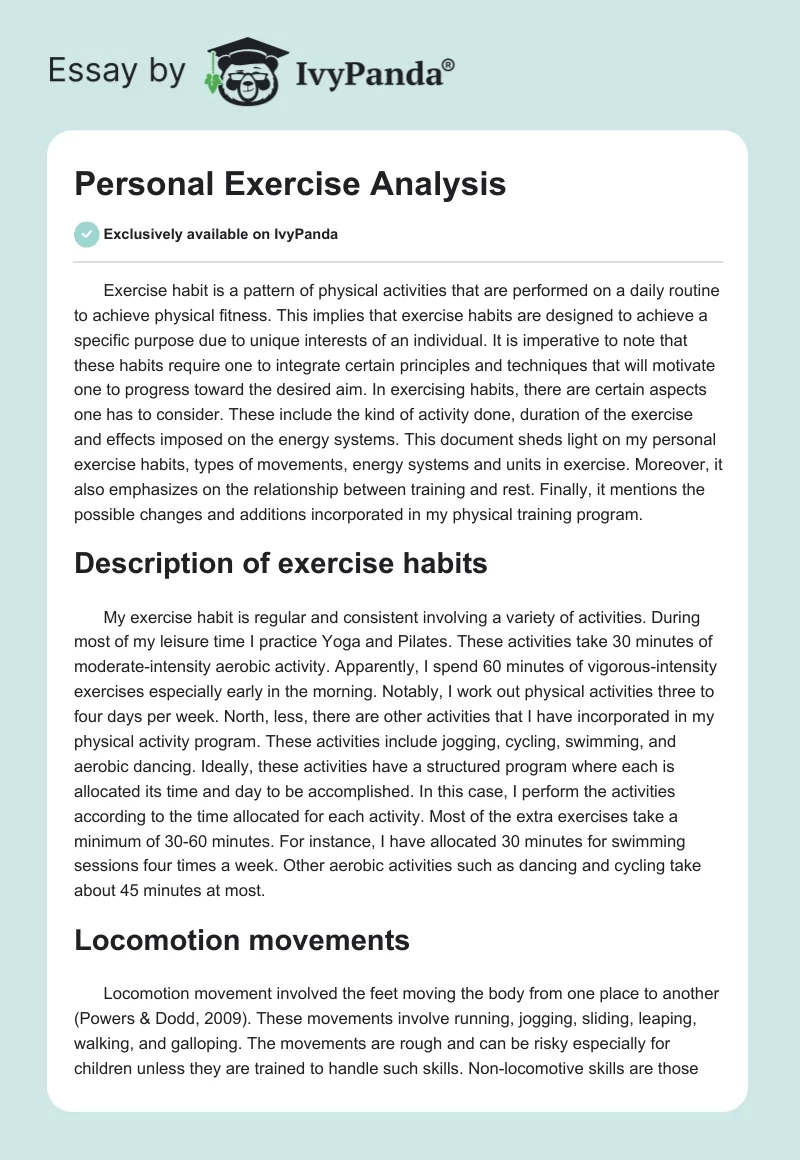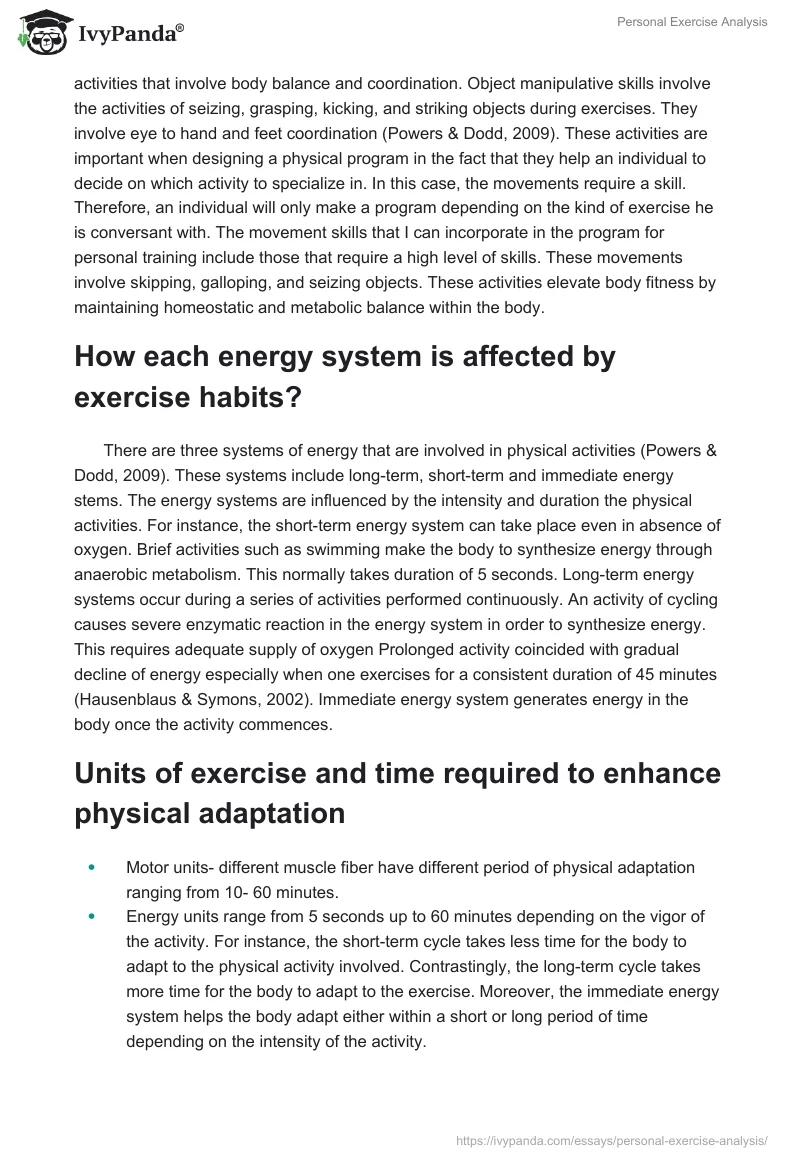- Description of exercise habits
- Locomotion movements
- How each energy system is affected by exercise habits?
- Units of exercise and time required to enhance physical adaptation
- Impact of the exercise as it relates to either aerobic or anaerobic power
- Relationship between the time needed to train and rest
- Potential issues in developing motor skills and motor learning
- Changes or additions to the training program
- References
Exercise habit is a pattern of physical activities that are performed on a daily routine to achieve physical fitness. This implies that exercise habits are designed to achieve a specific purpose due to unique interests of an individual. It is imperative to note that these habits require one to integrate certain principles and techniques that will motivate one to progress toward the desired aim. In exercising habits, there are certain aspects one has to consider. These include the kind of activity done, duration of the exercise and effects imposed on the energy systems. This document sheds light on my personal exercise habits, types of movements, energy systems and units in exercise. Moreover, it also emphasizes on the relationship between training and rest. Finally, it mentions the possible changes and additions incorporated in my physical training program.
Description of exercise habits
My exercise habit is regular and consistent involving a variety of activities. During most of my leisure time I practice Yoga and Pilates. These activities take 30 minutes of moderate-intensity aerobic activity. Apparently, I spend 60 minutes of vigorous-intensity exercises especially early in the morning. Notably, I work out physical activities three to four days per week. North, less, there are other activities that I have incorporated in my physical activity program. These activities include jogging, cycling, swimming, and aerobic dancing. Ideally, these activities have a structured program where each is allocated its time and day to be accomplished. In this case, I perform the activities according to the time allocated for each activity. Most of the extra exercises take a minimum of 30-60 minutes. For instance, I have allocated 30 minutes for swimming sessions four times a week. Other aerobic activities such as dancing and cycling take about 45 minutes at most.
Locomotion movements
Locomotion movement involved the feet moving the body from one place to another (Powers & Dodd, 2009). These movements involve running, jogging, sliding, leaping, walking, and galloping. The movements are rough and can be risky especially for children unless they are trained to handle such skills. Non-locomotive skills are those activities that involve body balance and coordination. Object manipulative skills involve the activities of seizing, grasping, kicking, and striking objects during exercises. They involve eye to hand and feet coordination (Powers & Dodd, 2009). These activities are important when designing a physical program in the fact that they help an individual to decide on which activity to specialize in. In this case, the movements require a skill. Therefore, an individual will only make a program depending on the kind of exercise he is conversant with. The movement skills that I can incorporate in the program for personal training include those that require a high level of skills. These movements involve skipping, galloping, and seizing objects. These activities elevate body fitness by maintaining homeostatic and metabolic balance within the body.
How each energy system is affected by exercise habits?
There are three systems of energy that are involved in physical activities (Powers & Dodd, 2009). These systems include long-term, short-term and immediate energy stems. The energy systems are influenced by the intensity and duration the physical activities. For instance, the short-term energy system can take place even in absence of oxygen. Brief activities such as swimming make the body to synthesize energy through anaerobic metabolism. This normally takes duration of 5 seconds. Long-term energy systems occur during a series of activities performed continuously. An activity of cycling causes severe enzymatic reaction in the energy system in order to synthesize energy. This requires adequate supply of oxygen Prolonged activity coincided with gradual decline of energy especially when one exercises for a consistent duration of 45 minutes (Hausenblaus & Symons, 2002). Immediate energy system generates energy in the body once the activity commences.
Units of exercise and time required to enhance physical adaptation
- Motor units- different muscle fiber have different period of physical adaptation ranging from 10- 60 minutes.
- Energy units range from 5 seconds up to 60 minutes depending on the vigor of the activity. For instance, the short-term cycle takes less time for the body to adapt to the physical activity involved. Contrastingly, the long-term cycle takes more time for the body to adapt to the exercise. Moreover, the immediate energy system helps the body adapt either within a short or long period of time depending on the intensity of the activity.
- Skeletal units- repetitive actions take up to one hour and the muscles become physically adapted to the physical activity. However, muscle units should not be
Impact of the exercise as it relates to either aerobic or anaerobic power
When one starts an activity that is vigorous, the body does not get enough time to break down glucose into energy by use of oxygen (Hausenblaus & Symons, 2002). This makes the body to use the energy already stored in the body muscles. After the stored energy is exhausted, the body synthesizes chemicals that break down the glucose in absence of oxygen. This is what referred to as anaerobic power is. This occurs during short-burst activities such as short races. Nevertheless, certain activities require high amount of energy (Hausenblaus & Symons, 2002). This calls for the body to synthesize energy by use of aerobic power. This occurs during less intense activities such as riding. Aerobic power is slow and takes time to be metabolized. Exercise causes an increase in pulse rate and thus more oxygen is circulated into the body to breakdown carbohydrates and fats into energy.
Relationship between the time needed to train and rest
Training program is inclined to the energy components in the body. For instance, incase there is much time spent in training for a vigorous activity, the body should be given adequate rest to regenerate the energy used up. Evaluating the balance between training and rest in physical activity programs is very beneficial to an individual. The more vigorous an activity is, the more time an individual should take for the body to regenerate. It is evident that, high-level performers need to have enough rest and sleep for the body to get repaired and strengthen (Hausenblaus & Symons, 2002).
Potential issues in developing motor skills and motor learning
Motor skills involve the ability to use body muscles to perform certain activities. This movement triggers the brain to internalize foundations of lateral, directional and positional movement (Hausenblaus & Symons, 2002). This knowledge is transformed into symbols in real-life situations. Motor learning helps the brain to coordinate and interact with body movements that are both gross and fine. Through my exercise habit, my brain is able to master certain movements thus learn to sequence thoughts and recognize specific patterns.
Changes or additions to the training program
To enhance fitting in my training program, there are changes and additions that will be included. As an example, the schedule of exercise needs to be changed to ensure that the activities are done consistently without failure. Moreover, the schedules will be hourly based to enhance more exercising and training. As in addition, I intend to have an exercise partner as a competitor to increase motivation during exercises.
References
Hausenblaus, A. & Symons, D. (2002). How much is too much? The development and validation of the Exercise Dependence Scale. Psychology and Health, 16, 387-404.
Powers, K. & Dodd, L. (2009). Total Fitness & Wellness. San Francisco, CA: Person/Benjamin Cummings.


